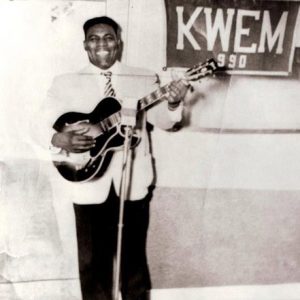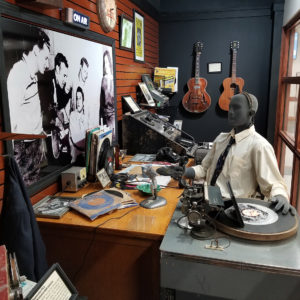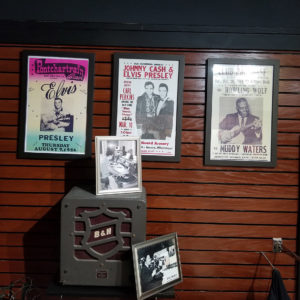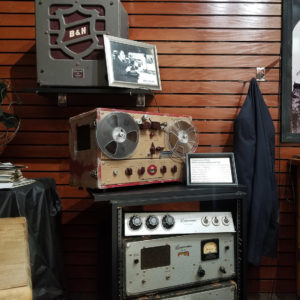calsfoundation@cals.org
KWEM
The landscape of American music was on the brink of change when KWEM began its first broadcast on February 23, 1947. The KXLR-Razorback Network brought its new station and a unique listening experience to West Memphis (Crittenden County), featuring local musicians who played live on the air. The success of live broadcasts on KFFA in nearby Helena (Phillips County) inspired KWEM to incorporate a “pay-to-play” revenue model, in which the opportunity to perform live on its daytime broadcasts was available to anyone able to secure a sponsor or pay a $15 fee. For emerging artists, appearances on KWEM provided exposure within the vibrant West Memphis music scene and ignited the rise to greatness for numerous musical legends, including Ike Turner, B. B. King, Johnny Cash, and Elvis Presley. After the station’s demise in 1960, it was revived in an online format a half century later.
The self-styled “Voice of the Tri-States” began as a daytime station, broadcasting on 990 AM from the western half of a building that later became a Regions Bank, at 231 East Broadway Boulevard. Seven years later, KWEM opened a second studio inside a Quonset hut located in midtown Memphis, Tennessee. KWEM made no distinction regarding race or musical genre—black and white artists alike had equal access to an audience through the “pay-to-play” model. The staying power of a particular style or artist was determined by public demand. Impressive daytime performances featured on KWEM often translated into nighttime event bookings in one of several live venues throughout the Arkansas Delta region, or across the river in Memphis, and even gave rise to opportunities beyond the local music scene.
Singer/songwriter and blues harmonica player “Sonny Boy” Williamson II achieved local fame through his performances on KFFA before making the journey to West Memphis, where he headlined his own KWEM show from 1948 to 1950. Williamson’s show featured several colleagues from the regional blues circuit, including Howlin’ Wolf and the legendary B. B. King, whose brief stints on KWEM led to a show of his own on WDIA in Memphis. Blues performers who made appearances on KWEM during this era included Ike Turner, Junior Parker, James Cotton, Willie Mitchell, Elmore James, Hubert Sumlin, Bobby “Blue” Bland, Rosco Gordon, Willie Nix, and one-man-band Joe Hill Louis (a.k.a. “The Be-Bop Boy”). The lineup of talented artists featured on KWEM grabbed the attention of Sam Phillips, founder of Sun Records in Memphis, who was so moved upon hearing Howlin’ Wolf for the first time that he remarked: “This is for me! This is where the soul of man never dies.” Howlin’ Wolf headlined his own daily show on KWEM from 1949 to 1952, which laid the groundwork for a successful recording career, beginning with Phillips at Sun Records.
The first radio appearance for eighteen-year-old Elvis Presley came in 1953, when he performed on KWEM with rockabilly act Johnny Burnette & the Rock and Roll Trio. Guitarist Scotty Moore and bassist Bill Black (both KWEM regulars) went on to collaborate with Presley in recording sessions at Sun Records, which led to the 1954 release of Presley’s first successful single, “That’s All Right (Mama).” The upbeat rockabilly sound lit up local airwaves, the first of many hits that transformed Presley into a musical legend. Moore and Black were also part of Presley’s backing band for the next several years.
KWEM also featured, in 1954, the first radio appearance of Johnny Cash, who performed gospel and country with Luther Perkins and Marshall Grant on their own weekly show. Cash and his backing duo—billed as “Johnny Cash and the Tennessee Two”—began their rise to stardom at Sun Records with a string of successful singles: “Hey, Porter,” “Cry! Cry! Cry!” and “Folsom Prison Blues,” all released in 1955.
Live performances on KWEM came to an end in 1955, and operations ceased in 1960. The station was eventually sold, moved to Memphis, and renamed KWAM, where it began broadcasting in a talk radio format. But the blend of blues, rhythm, country, and rockabilly woven together on its airwaves helped ignite the evolution of rock and roll, and firmly established the preeminence of the “Memphis sound” into the character of mid-twentieth-century music.
KWEM was resurrected via an online format in 2009 by Memphis resident Dale Franklin, who became interested in preserving the legacy of the station during his research for a documentary film. Mid-South Community College (now Arkansas State University Mid-South) purchased the station in 2013 and incorporated its online broadcasts into a replica studio exhibit on its campus. The twenty-four-hour streaming format features music from original KWEM alumni, as well as material from classic and contemporary blues, rock, and rockabilly artists.
For additional information:
Blinder, Alan. “Emerging from the Shadows Cast across a River.” New York Times, June 1, 2014, p. 10A. Online at http://www.nytimes.com/2014/06/02/us/kwem-return-has-west-memphis-reliving-its-role-in-radio-history.html?_r=0 (accessed November 6, 2020).
KWEM Radio. http://www.kwemradio.com/ (accessed November 6, 2020).
Poindexter, Ray. Arkansas Airwaves. North Little Rock, AR: 1974.
Suriani, Mike. “KWEM Radio in West Memphis Back on the Air after 54-Year Silence.” WREG News Channel 3, June 3, 2014. http://wreg.com/2014/06/03/kwem-radio-in-west-memphis-back-on-the-air-after-54-year-silence/ (accessed November 6, 2020).
Adam Miller
Austin, Texas
 Mass Media
Mass Media Music and Musicians
Music and Musicians World War II through the Faubus Era, 1941 through 1967
World War II through the Faubus Era, 1941 through 1967 Howlin' Wolf
Howlin' Wolf  KWEM Automobile
KWEM Automobile  KWEM Display
KWEM Display  KWEM Display Items
KWEM Display Items  KWEM Display Items
KWEM Display Items  KWEM Studio
KWEM Studio 




Comments
No comments on this entry yet.